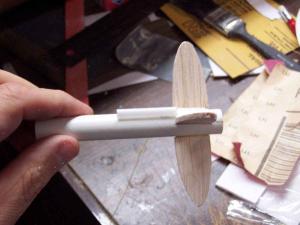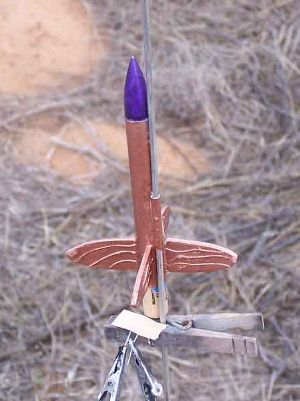| Construction Rating: | starstarstarstarstar_border |
| Flight Rating: | starstarstarstarstar_border |
| Overall Rating: | starstarstarstarstar_border |
| Diameter: | 0.54 inches |
| Manufacturer: | HotRod Rockets  |
| Skill Level: | 1 |
| Style: | Sport |

Brief:
The Fruit Fly was a nice minimum diameter rocket from HotRod Rockets. Unfortunately, it has been discontinued. It is
a simple build with elliptical wings reminiscent of those of an insect. It has a resin nose cone and streamer recovery
which should make it easier to recover this light rocket.
Construction:
The first step in construction is to insert the thrust ring. The instructions call for the use of a spent 13mm
casing. I had only one that had been sawed up but checking the length, there was enough to get the ring where it was
supposed to go. It was glued with white glue.
Next came the cutting of the fins. A template is provided on a piece of stiff cardstock which is a pleasant change from light bond paper. The template was cut out and the outlines of 4 fins were traced onto the balsa sheet. The cardstock meant that the template kept its shape as well for the 4th fin as it did for the 1st. The fins were then cut out with a razor knife.


One of the fins was selected to serve as the anchor for the Kevlar® shock cord. A small notch was cut out of the top and bottom of this fin.
The kit came with a wraparound fin marking guide. It too was printed on cardstock like the fin template. While that was handy and appreciated for the template, it was less handy here. There were no real problems, it just did not wrap as easily as paper would have. It was cut out, wrapped around the BT, and the marks were transferred. The wrap guide joint was used as a mark for the launch lug.
After the fin lines were extended with an angle iron, each was given a tick mark 1/4" from the aft end to mark the back of the fins. The fins were then applied using yellow glue and a double joint.
The instructions say to tie the Kevlar® around the base of the fin with the notches in it. Instead of doing that, I glued the end of the Kevlar® along side of the notched fin with the long end hanging down. When that dried, I wrapped it around the bottom and glued it along the base on the other side. This prevented the frustration of trying to tie a good knot and hide the knot in the fillets.


Filleting was done with white glue. It was applied to the joint and smoothed out with a finger. While this was being done, I took the opportunity to apply the launch lug as well.


The sewing elastic was tied into the Kevlar® and the knot was firmed up with a bit of white glue. The provided streamer looks to be a Sky Gripper from Hartle Engineering. I used one of the provided tape strips to affix it to the Kevlar®. The cast resin nose cone proved to be quite loose. I applied several wraps of cellophane tape around the base and then used a razor knife to trim back the excess. It then fit the BT well.

Finishing:
Finishing of the Fruit Fly began with priming. I decided not to try and fill the balsa in what, perhaps, is a vain
hope. I am hoping that a little of the grain will show through on the final paint job to give the
"impression" of the vasculature found in insect wings. It may or may not work but I decided to give it a try.
I used some cellophane tape to cover up the part of the Kevlar® shock cord that would be exposed to most of the paint stream. The rocket was then put in the booth and given a coat of Kilz. The nose cone was sprayed separately hanging from its harness. I wish I had waited to install it.
While waiting for the primer to dry, I got a suggestion from CharlaineC on TRF about the veins in the insect wings. She suggested that I glue pieces of thread on the fins to simulate them. It seemed like such a sensible idea that I decided to give it a try.
Before applying the veins, I first needed to sand down the Kilz. This was done with #400 sandpaper until the fins were smooth. I then took out some black rayon thread and fixed the end near the root with a spot of CA. When the CA had grabbed, I proceeded to stretch out the thread along the fin in a "random curved" manner, tacking it down with more CA. When I reached the endpoint of a fin, I used a razor to slice off the excess.
I tried to give three veins per side of a fin. My first impression was that it looked pretty tacky right but then I remembered feeling the same way when using thread to give some relief to a nozzle on a Dr. Zooch Discoverer Thor. After it was painted though, it looked great.


I got about 3/4 through this time consuming operation before I had to give up and do other stuff in order to stay gainfully employed. When I got back to it, I only had one fin left to do and that went more quickly than I remembered. It still didn't look great, but I was counting on the paint to change things.
I couldn't think of a good way to mask this rocket so I decided to take a slow approach that I thought would work. I decided to mask and do one fin at a time, hoping that I could control things that way. Accordingly, the first fin was masked and then the fin go 2 coats of a Rustoleum copper. The paint came out significantly darker than the can lid indicated but I like copper.


When the first masking was removed, I found lots of bleeding from under the tape. This as not along the edges of the fins but rather, at the fore and aft tips. Thinking I would fix this later, I tried to do a better job of masking the second fin. It too got 2 coats of copper.
After peeling back the masking on the third fin, I realized that I was fighting a losing battle. There was way too much leaking under the masking and the rocket looked bad. The paint had helped with the veins in the fins but the rest looked bad. It was time for a new strategy.


Since finishing is not my forte and I did not want to strip things bare, I decided that the entire body was going to be copper. The booth was busy so I stuck the rocket on a rod and took it out in the yard where the entire thing except for the nosecone was painted copper.
The rocket sat painted in nothing but copper for a few weeks because I was too busy to get to it. Then I found I had a day before my next club launch and I just gave the cone a shot of metallic purple. It would have to do.
Construction Rating: 4 out of 5

Flight and Recovery:
When I prepped the Fruit Fly for its maiden flight, I did want to get it back so I started slow with a 1/4A3-3T. Some
tape was used for a friction fit and the rocket was put on the pad. After a couple of misfires, it took off just fine
but the ejection charge snapped off the Kevlar®
just before the attachment point to the elastic. Since the steamer was on the nosecone portion, both parts were
recovered with no other harm than the snapped cord. A
video of the maiden flight can be seen here.
Flight Rating: 4 out of 5
Summary:
The rocket flies well and will probably scream when I get it fixed up again. I need to try it on an A but I need to
rethink the shock mount.
I like the rocket and will repair it. It has its niche in the scheme of things. Its easy to build and need not be a hassle to assemble. That was my doing.
Overall Rating: 4 out of 5
Other Reviews
- HotRod Rockets Fruit Fly By Charlaine Cadence Nordin (May 23, 2009)
Brief: Hotrod's rockets Fruit fly is a small but great flier. It is a simple build and great for groups. Construction: Parts include: Cast resin nosecone Balsa fins Kevlar ® shock cord BT-5 body tube Thrust ring Streamer recovery The four fins are first cut from the balsa and sanded. One fin is notched for the mounting of the shock cord. ...
Sponsored Ads
 |
 |











